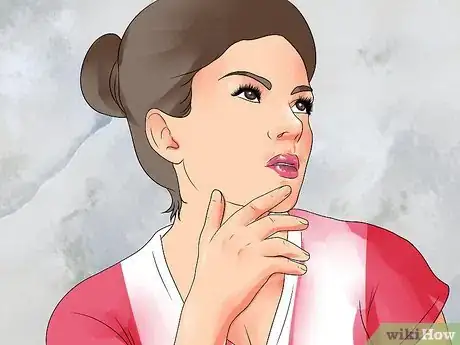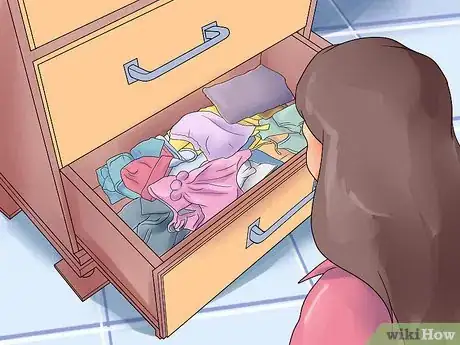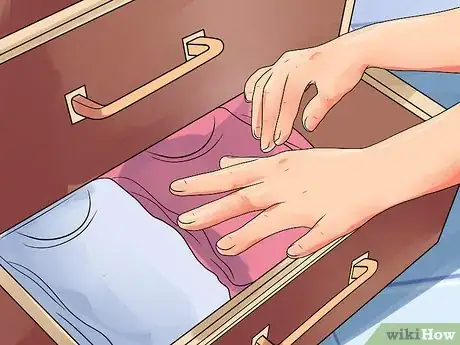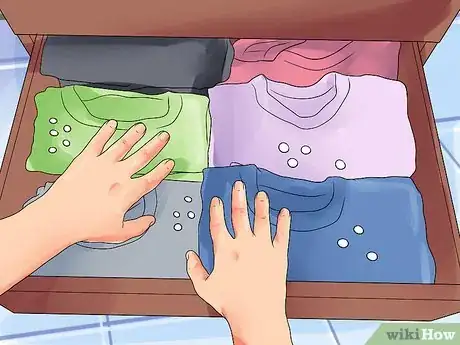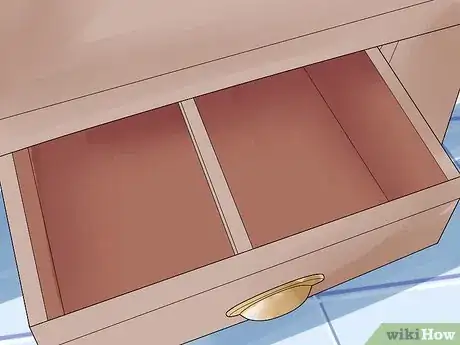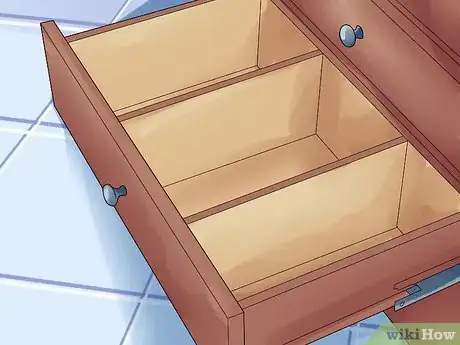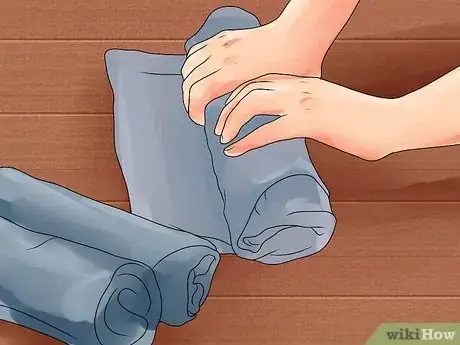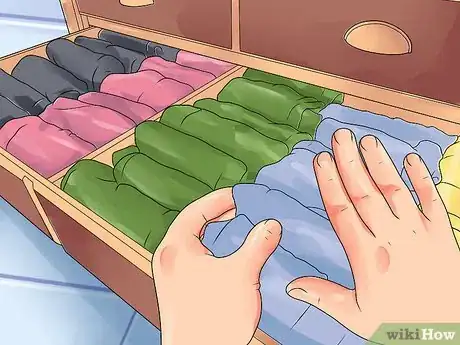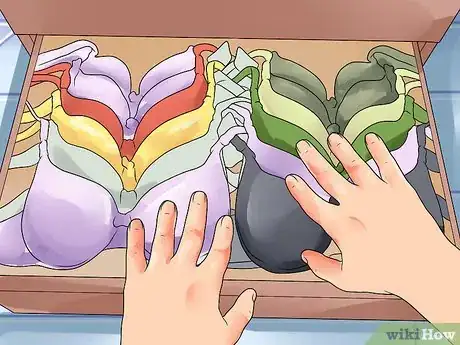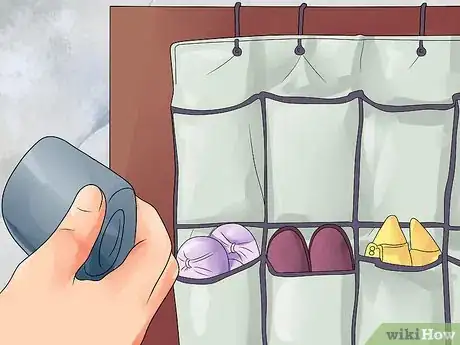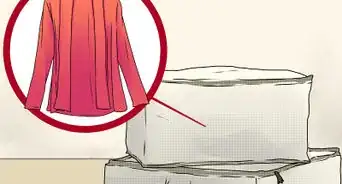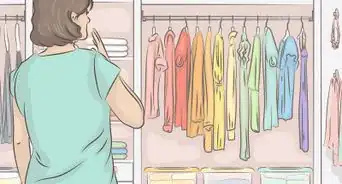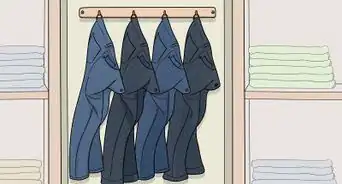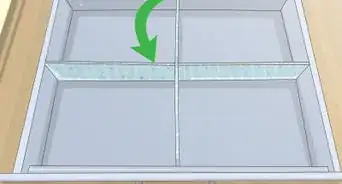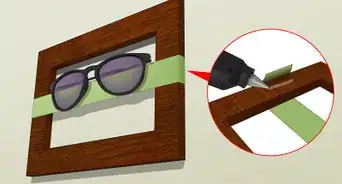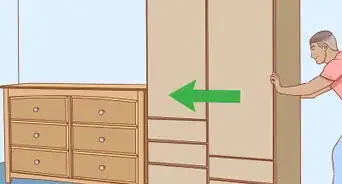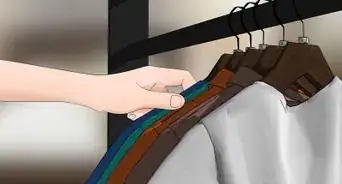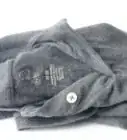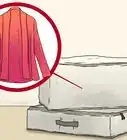This article was co-authored by Karen Parziale. Karen Parziale is a Home Stager, Home Organizer, and the Founder of The Real Estate Staging Studio based in Hoboken, New Jersey. Karen has over 15 years of home staging and decorating experience and has staged over 5,000 homes. She specializes in project management, space planning, material selections, and builder, architect, and client relationships.
wikiHow marks an article as reader-approved once it receives enough positive feedback. In this case, 88% of readers who voted found the article helpful, earning it our reader-approved status.
This article has been viewed 167,654 times.
Do you open your dressers only to have it look like a raccoon took a nap in there? Do you feel like you have more clothes than you can possibly store? Organizing a dresser drawer is a great solution to either of these problems and can also help you make sure that all of your favorite items get worn equally, instead of just always wearing those two or three tees at the top.
Steps
Sorting Your Clothes
-
1Figure out what items you can get rid of. Start your dresser organization project by taking everything out. Go through all the items and figure out what you can get rid of. Look for items that don’t fit, items that have gone out of style, items with stains or other signs of wear, and items that you just don’t wear very often.[1] Items in better condition can be donated but items in poor condition can simply be thrown away.
- You might be keeping some items for sentimental purposes, even long after they become unwearable. Try to find another use for items like this, like making a tee-shirt rug or a quilt, so that they aren’t taking up space in your drawers.
- If it’s a casual or daily item and you haven’t worn it in a year, it’s time for it to go. Formal items can go unworn a bit longer.
-
2Separate seasonal items. Now that you’ve limited yourself to the items you want to keep, separate the items by what season they’re appropriate for. You can switch your dresser contents for warm weather and cold weather, storing the off-season items in a plastic bin in a closet or basement until they’re needed.
- You can also store off season items in a box under your bed.
- At the very least, you'll want to put heavy winter items in the lowest drawers. This is better for your dresser.
Advertisement -
3Organize your clothes by type. Organize all of your clothes by their function. Generally you will have delicates, pajamas, casual shirts, dress shirts, casual pants, dress pants, heavy sweaters and light sweaters. Pants should really be stored separately, as should sweaters, so try to set aside a drawer just for these items.
- Generally, these items can be split very nicely between four drawers. Delicates and pajamas in one drawer, shirts in another, pants in a third, and sweaters and other items in the fourth.
- Sweaters should be kept separately to help protect them from moths but also to keep them from pilling all over other clothing items. Pants must generally be folded differently from shirts and keeping them separate will prevent wrinkles.
-
4Organize your clothes by function. Within each of the categories that you've now set aside, you will now want to organize items by how they should sit within their section. There are different schools of thought, and some people prefer to organize by function while some would rather organize by color. It's up to you.
- For functional separation, look for the common pairs. Lightweight items vs heavy items, casual items vs formal items, flirty items vs professional items, etc. This can help you find the clothes you want more quickly, because you will know exactly where to look. It also keeps items with similar materials together.
- However, separating by color will make your drawers look much nicer and help you stay motivated to keep them organized.
-
5Separate items by how they're best stored. With all of your clothes divided up, you'll have to decide what items go in what drawers. Generally, you want to put items you use most frequently towards the top. You also want to try to place lighter items at the top, to create the least amount of strain on your dresser.[2]
- Some clothing types might need special storage considerations too. For example, placing a cedar plank or mothballs in a drawer with sweaters is important for combating moths.
- Some items might also need to be stored hanging up or in a bag, instead of in a drawer. It's a good idea to identify these items and set them aside. Examples of these items would be any item made of silk, as they will wrinkle very easily when folded, or very expensive or irreplaceable sweaters, which should be stored in bags to protect them from moths.
Sectioning Your Clothes
-
1Divide the drawers into sections. One drawer is usually too big for all of the different types of items it contains. Visually divide the drawer into sections so that you can keep your clothes sorted by how you use them. For long drawers, dividing into three is a good place to start. Divide smaller drawers into two sections.[3]
- The sections can then be further divided as needed. For example, you might have your top long drawer divided into three. Bras can be nested in the first section, the second section can be divided into two parts, one for socks and the other for pajamas. The third section can be divided into three parts, for the different types of underwear you have.
-
2Try using bins. You can use open bins, like the nice wicker or fabric bins that you see at home stores, to enforce the sections that you've broken your drawers in to. Find bins in different sizes and them put them in your drawers. Your clothes can then be put into the bins.[4]
- This will help keep everything separate but it also means you can take out and rearrange the drawers without having to take out and refold all your clothes.
-
3Try using dividers. If you want to preserve space and money, you can simply put dividers into the drawer. You can get commercial dividers, which are like extending curtain rods but flat and can be set to the size of any drawer. These are easily purchased wherever other laundry items like baskets and ironing boards are sold.[5] You can also make dividers out of cardboard or foam board.
- Another great option is to save the divider that comes with a box of wine. This is great for storing sock, underwear, and other small items.
-
4Try using bookends. Another quick cheat is to use basic metal bookends. These can be purchased (often for less than $5 a pair) at any store that sells office supplies. Stand them up in your drawers and you'll have an easy way to divide the space.
- The downside to these is that they don't create a solid line, which can make it hard to keep small items separate. However, they're perfect for things like rolled shirts, jeans, and sweaters.
-
5Try other items in a pinch. There are also lots of other items you can use to divide and organize your drawers. You can use a simple dish rack, a pill organizer for small items like jewelry, pudding cups or an ice cube tray for jewelry or socks and tights, etc. Just look for any containers which are designed to keep items contained and separate. If it works outside a dresser, it will probably work inside one too.
Storing Items Efficiently
-
1Try rolling items. By now, you’ve probably heard the advice that you should roll your clothes when you pack a suitcase. Your drawers at home aren’t any different. Rolling takes up less space and it also prevents wrinkles and creases when done correctly. Make your rolls slowly and get them nice and tight in order to prevent wrinkles.
- The exception here is if you have clothes with natural creases in them. Creased pants, for example, should probably be folded in the traditional way, although they are really best kept in a closet.
-
2Use a shirt board. If you do fold your clothes, use a shirt board when you fold them. This is a board like a clipboard or even a piece of cardboard which you fold your shirt or pants around. Place the board at the top center of a shirt, just at the collar. Pull the left sleeve over toward the right, until it creases at the side of the board, and then repeat for the right. Tuck the sleeves as needed and then fold up the bottom hem. Pants are simply folded in half and then wrapped around the board.
- You can remove the board (as is more traditional), but if you used cheap cardboard, you can leave the board in the shirt or pants. This makes it faster to sort through the items or even store them vertically, like the bagged dress shirts at a department store.
- To make your own shirt board, cut a piece of thick cardboard to about 15” by 18”. It should be just about the same size that a shirt is once folded into a “store style” rectangle.
-
3File items, don't stack them. When you put items into your drawers, don’t stack them. This is the traditional way to place items in a drawer, but it makes it very easy to wrinkle them and makes it hard to find the item that you want. Instead of stacking, “file” your items.[6] Place clothes in upright rolls, side rolls, or folded with a shirt board and kept like actual files.
- You can even use a file organizer in your drawers to help keep items upright.
-
4Nest bras to maintain them. If you have bras to store in your dresser, be sure to nest them. This means placing the curve of the cup into the curve of the cup of the next bra. This will not only save space and make your drawer more organized, it will also preserve the integrity of the bra, helping it stay strong and supportive for longer.
- You can store them in one big line or you can place the left cup inside of the right cup to conserve space, although this is less good for the center of the bra and can lead to warping.
-
5Consider an alternative for sock storage. Sock drawers are one of those drawers that quickly turn into a mess. You can ball socks in order to keep them together and make your drawer more organized, but this is bad for the elastic.[7] Folded socks will quickly come apart as you look for the pair you want and pull items from a drawer. A better solution for socks is to not store them in your dresser. Instead, use a hanging shoe organizer with pockets. This can go in your closet, in your bathroom, or on the back of your bedroom door. Each pair of socks gets a pocket and you no longer have to worry about folding or looking for just the right pair.
- Another option is to use pudding cups or drink cups in your drawer and put the socks in those. However, this is not very space efficient. It will make your drawer more organized but it will also take up a lot of space. Choose what's best for you.
Expert Q&A
-
QuestionWhat can I use as a drawer divider?
 Karen ParzialeKaren Parziale is a Home Stager, Home Organizer, and the Founder of The Real Estate Staging Studio based in Hoboken, New Jersey. Karen has over 15 years of home staging and decorating experience and has staged over 5,000 homes. She specializes in project management, space planning, material selections, and builder, architect, and client relationships.
Karen ParzialeKaren Parziale is a Home Stager, Home Organizer, and the Founder of The Real Estate Staging Studio based in Hoboken, New Jersey. Karen has over 15 years of home staging and decorating experience and has staged over 5,000 homes. She specializes in project management, space planning, material selections, and builder, architect, and client relationships.
Home Stager & Interior Designer It's going to be much easier to just buy drawer dividers. They're extremely cheap, and they come in all different kinds of styles, shapes, and sizes.
It's going to be much easier to just buy drawer dividers. They're extremely cheap, and they come in all different kinds of styles, shapes, and sizes. -
QuestionWhere can I buy drawer dividers?
 Karen ParzialeKaren Parziale is a Home Stager, Home Organizer, and the Founder of The Real Estate Staging Studio based in Hoboken, New Jersey. Karen has over 15 years of home staging and decorating experience and has staged over 5,000 homes. She specializes in project management, space planning, material selections, and builder, architect, and client relationships.
Karen ParzialeKaren Parziale is a Home Stager, Home Organizer, and the Founder of The Real Estate Staging Studio based in Hoboken, New Jersey. Karen has over 15 years of home staging and decorating experience and has staged over 5,000 homes. She specializes in project management, space planning, material selections, and builder, architect, and client relationships.
Home Stager & Interior Designer You can get them at most big box department stores. There's usually a good selection at The Container Store, as well.
You can get them at most big box department stores. There's usually a good selection at The Container Store, as well. -
QuestionHow can I make homemade dividers that do not take too long to make?
 Community AnswerUse cardboard boxes! I cut a heavy duty corrugated cardboard box to the right size and slid it in. Make sure not to cut it too small, otherwise it won't stand up on its own.
Community AnswerUse cardboard boxes! I cut a heavy duty corrugated cardboard box to the right size and slid it in. Make sure not to cut it too small, otherwise it won't stand up on its own.
References
- ↑ http://www.overstock.com/guides/how-to-organize-a-dresser
- ↑ http://unclutterer.com/2010/08/10/reader-weigh-in-how-do-you-organize-your-clothes-dresser/
- ↑ Karen Parziale. Home Stager & Interior Designer. Expert Interview. 21 April 2020.
- ↑ Karen Parziale. Home Stager & Interior Designer. Expert Interview. 21 April 2020.
- ↑ Karen Parziale. Home Stager & Interior Designer. Expert Interview. 21 April 2020.
- ↑ http://www.apartmenttherapy.com/have-a-more-organized-monday-5-tips-for-tidying-your-dresser-drawers-136085
- ↑ http://www.wncwoman.com/2014/03/05/organizing-202-the-abcs-of-organizing-d-is-for-dresser-drawers/
About This Article
If your dresser drawers are getting out of control, there are a few simple ways to help you organize them. If you have a lot of clothes, only keep items for this season in your drawers and store the rest in boxes to save space. Try organizing your drawers by types of clothes. For example, if you have 4 drawers, store delicates and pajamas in 1 drawer, shirts in another, pants in the 3rd, and sweaters in the 4th. Alternatively, divide your drawers by function, such as casual, smart, and professional items. To save space, roll your clothes instead of folding them. If you need to divide your drawers further, buy some fabric bins or dividers. For more tips, including how to store jewelry and small items in your dresser, read on!
